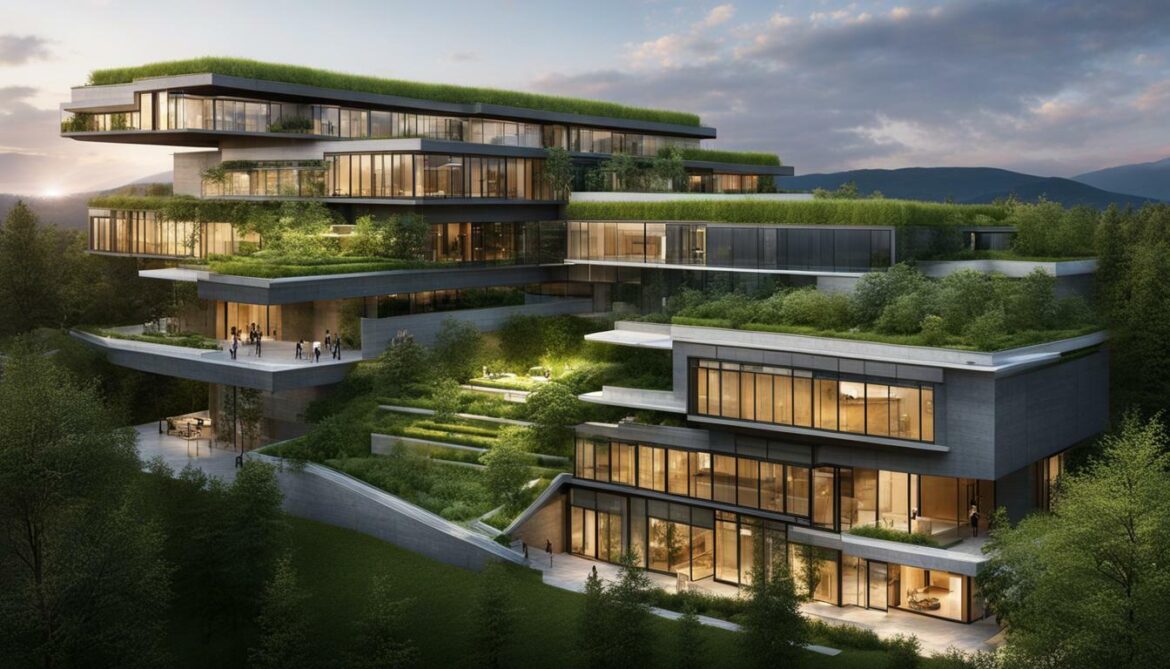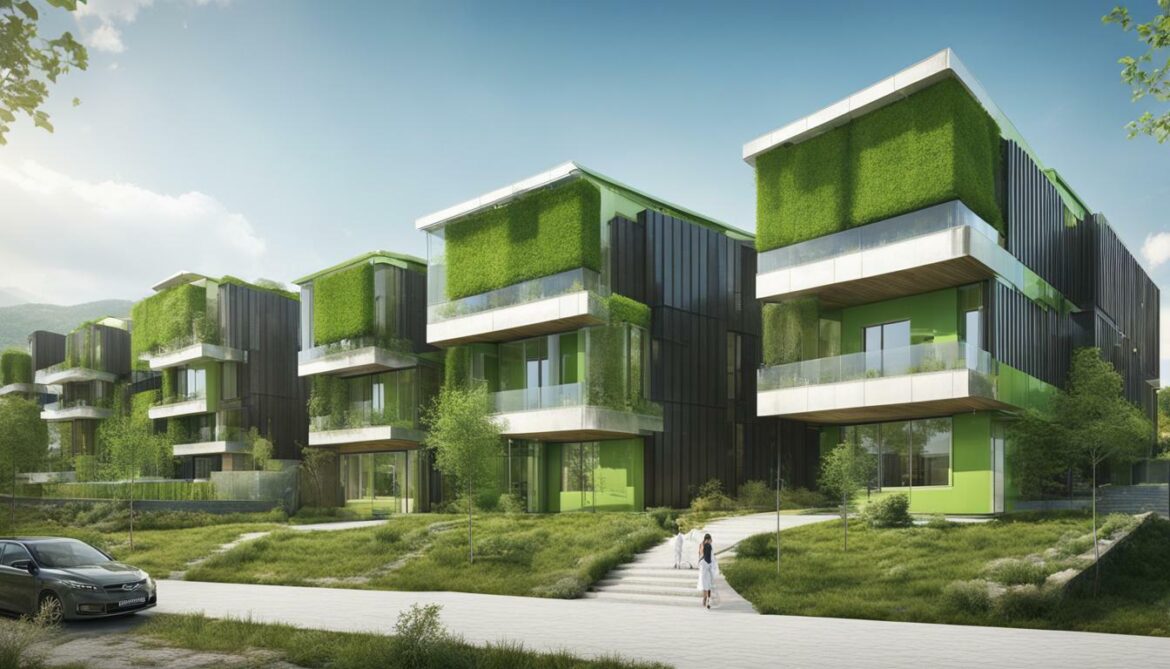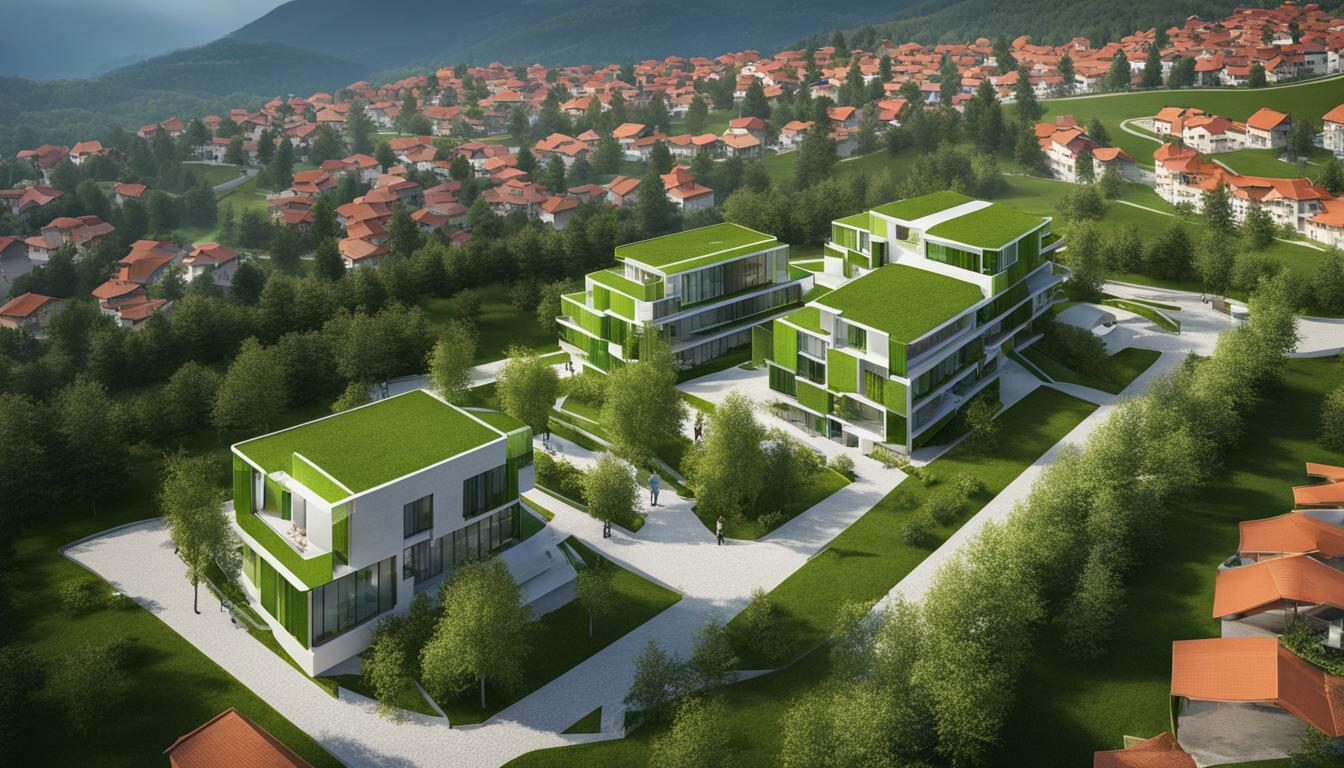Explore Kosovo Top Green Buildings, a testament to environment-friendly architecture. These sustainable structures showcase the commitment of the region to embrace eco-friendly design and contribute to a greener future. From energy-efficient construction practices to innovative initiatives, Kosovo is making significant strides in creating a more sustainable built environment.
- Kosovo is prioritizing sustainable architecture and eco-friendly buildings to promote a greener future.
- The energy-efficient construction practices adopted in Kosovo include green building design and the use of sustainable materials.
- Prizren, the second-largest city in Kosovo, is improving the energy efficiency of public buildings with financial support from the EBRD and the EU.
- Pristina, the capital city of Kosovo, has proposed a Zero Emission Neighborhood, focusing on sustainable residential architecture.
- The financing frameworks supporting Kosovo’s green transition include support from the EBRD and the EU.
These are just a few highlights of the remarkable progress that Kosovo has made in the realm of green buildings. Through sustainable architecture and environmentally conscious construction, Kosovo is setting an example for other regions to follow. By embracing a more energy-efficient and sustainable way of living, we can pave the way for a better future.
Energy-efficient Construction in Kosovo
Learn about the energy-efficient construction practices and sustainable design techniques used in Kosovo.
Kosovo is making significant strides towards energy-efficient construction and sustainable design, aiming to reduce its carbon footprint and create a greener future. The country has embraced innovative methods and materials to develop buildings that are both environmentally friendly and energy-efficient.

One of the key approaches is incorporating green building design principles. This involves designing and constructing buildings that have minimal impact on the environment throughout their entire lifecycle. From using eco-friendly materials to implementing energy-efficient systems, such as solar panels and smart lighting, these buildings are designed to maximize energy conservation and minimize waste.
In addition to green building design, Kosovo also prioritizes the use of sustainable building materials. These materials are sourced responsibly, taking into account factors such as their environmental impact, durability, and energy efficiency. By using sustainable materials, construction projects in Kosovo contribute to the reduction of carbon emissions and promote a more sustainable construction industry.
The commitment to energy-efficient construction in Kosovo extends beyond individual buildings. The country is actively investing in infrastructure projects that promote sustainability and reduce energy consumption. This includes initiatives like the insulation of public buildings in Prizren, supported by a €5 million sovereign loan from the European Bank for Reconstruction and Development (EBRD) and a €1 million grant from the European Union (EU). The project aims to improve the energy efficiency of 100 public buildings, such as kindergartens, schools, and primary healthcare facilities, significantly reducing their emissions.
In conclusion, Kosovo is taking significant steps towards energy-efficient construction and sustainable design. By incorporating green building design principles and using sustainable materials, the country is creating buildings that are not only aesthetically pleasing but also environmentally friendly. With the support of financing frameworks and initiatives like the insulation of public buildings in Prizren, Kosovo is on its way to becoming a leader in sustainable architecture and construction.
Prizren’s Public Buildings Initiatives
Discover how Prizren is transforming its public buildings into energy-efficient spaces with LEED certification and green infrastructure. With the help of a €5 million sovereign loan from the European Bank for Reconstruction and Development (EBRD) and a €1 million grant from the European Union (EU), Prizren, Kosovo’s second-largest city, is taking significant steps towards improving the energy efficiency of its public buildings.
The ambitious project aims to insulate 100 public buildings in Prizren, including kindergartens, schools, and primary healthcare facilities, with the goal of reducing their emissions by half. By implementing green building practices and technologies, such as LEED certification and green infrastructure, Prizren is creating sustainable and environmentally conscious spaces that prioritize energy efficiency.
LEED certified buildings in Kosovo adhere to stringent sustainability standards, ensuring that they are designed, constructed, and operated with the environment in mind. These buildings contribute to reduced energy consumption, lower carbon emissions, and improved indoor air quality. Additionally, green infrastructure initiatives, such as the incorporation of green roofs and rainwater harvesting systems, help mitigate the environmental impact of public buildings in Prizren.

The efforts in Prizren are part of a larger green transition taking place in Kosovo, with various financing frameworks supporting the country’s sustainable development goals. By investing in energy-efficient construction and environmentally conscious practices, Prizren is setting an example for other cities in Kosovo and beyond, showcasing the benefits of green buildings and the positive impact they can have on our environment and quality of life.
Zero Emission Neighborhood in Pristina
Learn about Pristina’s innovative plan for a Zero Emission Neighborhood, incorporating sustainable architecture and zero emission buildings. The city of Pristina in Kosovo is taking steps towards a greener future with its proposed Zero Emission Neighborhood. This project aims to create a sustainable residential area that prioritizes energy efficiency, reducing carbon emissions, and enhancing the overall quality of life for its residents.
The Zero Emission Neighborhood in Pristina will feature zero emission buildings, which are designed to minimize the environmental impact by using renewable energy sources and implementing passive design strategies. These buildings will be equipped with energy-efficient appliances and utilize active solar systems to generate clean energy for daily operations.
By integrating a combination of sustainable architecture, passive design strategies, and energy-efficient appliances, the Zero Emission Neighborhood in Pristina aims to create a community that is environmentally friendly and reduces its carbon footprint. The use of renewable energy sources and energy-efficient technologies will not only contribute to a cleaner environment but also result in significant cost savings for residents in terms of reduced energy consumption.
This forward-thinking initiative reflects Kosovo’s commitment to sustainable development and its transition towards a greener future. By focusing on zero emission buildings and incorporating sustainable design principles, Pristina is setting an example for other cities and regions worldwide, paving the way for a more sustainable and energy-efficient approach to urban planning and development.

| Features of the Zero Emission Neighborhood in Pristina |
Benefits |
| Zero emission buildings |
Minimizes carbon footprint and reduces environmental impact |
| Passive design strategies |
Optimizes natural resources for heating and cooling, reducing energy consumption |
| Active solar systems |
Generates clean energy for powering buildings and appliances |
| Energy-efficient appliances |
Reduces energy consumption and promotes sustainable living |
Financing Kosovo’s Green Transition
Explore the financing frameworks driving Kosovo’s green transition and supporting sustainable development. Kosovo’s efforts to embrace environmentally friendly practices and develop a more sustainable future are being fueled by various financial support mechanisms. One of these is a €5 million sovereign loan from the European Bank for Reconstruction and Development (EBRD). Additionally, the European Union (EU) has provided a €1 million grant to further support Kosovo’s green transition.
The funding is being utilized to improve the energy efficiency of public buildings, with a particular focus on Prizren, Kosovo’s second-largest city. Through this initiative, 100 public buildings, including kindergartens, schools, and primary healthcare facilities, will be insulated to reduce their emissions by half. This substantial investment will not only bring about significant environmental benefits in terms of reduced energy consumption and carbon footprint but also improve the overall quality of public infrastructure in Prizren.
Furthermore, the city of Pristina, Kosovo’s capital, has proposed the development of a Zero Emission Neighborhood that will prioritize sustainable residential architecture. This ambitious project will incorporate zero emission buildings, passive design strategies, active solar systems, and energy-efficient appliances. By creating a community that prioritizes eco-friendly practices, Pristina aims to enhance the quality of life for its residents and make a substantial contribution to Kosovo’s green transition.
These financing frameworks play a vital role in driving Kosovo’s green transition by enabling the implementation of sustainable development practices. By investing in energy-efficient infrastructure and promoting environmentally friendly initiatives, Kosovo is paving the way for a greener and more sustainable future.

| Financing Frameworks |
Description |
| European Bank for Reconstruction and Development (EBRD) loan |
A €5 million sovereign loan provided by the EBRD to support the energy efficiency improvements of public buildings, particularly in Prizren. |
| European Union (EU) grant |
A €1 million grant provided by the EU to further support Kosovo’s green transition and sustainable development initiatives. |
Benefits of Green Buildings in Kosovo
Discover the numerous benefits of green buildings in Kosovo, including energy efficiency and a healthier environment. Green buildings are designed with sustainability in mind, incorporating features and technologies that minimize their environmental impact. By implementing energy-efficient systems and using sustainable materials, these buildings contribute to a more sustainable future for Kosovo.
One of the key benefits of green buildings is improved energy efficiency. These buildings are designed to maximize energy conservation, reducing the amount of energy required for heating, cooling, and lighting. By incorporating insulation, efficient HVAC systems, and advanced lighting technologies, green buildings can significantly reduce energy consumption and lower utility costs for occupants.
Furthermore, green buildings promote a healthier indoor environment. They prioritize air quality through proper ventilation systems and the use of low VOC (volatile organic compounds) materials, reducing the risk of respiratory issues and improving overall well-being. Additionally, green spaces and natural lighting within these buildings create a pleasant and productive atmosphere, enhancing the quality of life for occupants.
“Green buildings are not only beneficial for the environment, but they also have a positive impact on human health and well-being,” says sustainable architect Ana Green.
“The integration of energy-efficient appliances, sustainable materials, and passive design strategies not only reduces carbon emissions but also creates comfortable and eco-friendly living spaces.”
Table: Comparison of Energy Consumption in Green vs. Conventional Buildings
| Energy Source |
Green Buildings |
Conventional Buildings |
| Electricity |
Reduced consumption through efficient systems |
Higher consumption due to inefficient systems |
| Heating/Fuel |
Lower energy demand through insulation and efficient heating systems |
Higher energy demand due to poor insulation and outdated heating systems |
| Water |
Efficient water fixtures and rainwater harvesting systems |
Higher water usage due to inefficient fixtures and lack of conservation measures |
Investing in green buildings not only benefits the environment and occupants but also stimulates the local economy. The construction and maintenance of green buildings create new job opportunities in the sustainable architecture and building materials sectors. Additionally, the reduced energy consumption in these buildings leads to lower utility bills, allowing occupants to allocate their savings towards other aspects of their lives.

With the support of various financing frameworks, such as the European Bank for Reconstruction and Development and the European Union, Kosovo is making significant strides towards a greener and more sustainable future. The initiatives taken in Prizren and the proposed Zero Emission Neighborhood in Pristina demonstrate the commitment to environmentally conscious construction and design practices.
In conclusion, green buildings in Kosovo provide multiple benefits, ranging from energy efficiency and improved air quality to job creation and a reduced carbon footprint. By embracing sustainable architecture and construction practices, Kosovo is paving the way for a more sustainable and prosperous future.
Conclusion
In conclusion, Kosovo’s top green buildings showcase the region’s commitment to sustainable architecture and environmental consciousness. The initiatives taken in Prizren, the second-largest city in Kosovo, demonstrate significant progress in improving the energy efficiency of public buildings. With a €5 million sovereign loan from the European Bank for Reconstruction and Development (EBRD) and a €1 million grant from the European Union (EU), Prizren aims to insulate 100 public buildings, including kindergartens, schools, and primary healthcare facilities. This ambitious project will reduce emissions by half, contributing to a greener and more sustainable future for the city.
Moreover, the proposed Zero Emission Neighborhood in Pristina, Kosovo’s capital city, further exemplifies the region’s dedication to environmentally friendly living. This innovative residential development focuses on sustainable architecture, incorporating zero emission buildings, passive design strategies, active solar systems, and energy-efficient appliances. By creating a community that prioritizes sustainable practices, Pristina aims to enhance the quality of life for its residents while minimizing its environmental impact.
These initiatives are part of Kosovo’s broader green transition, which is being supported by various financing frameworks. The European Bank for Reconstruction and Development (EBRD) and the European Union (EU) have been instrumental in providing financial assistance to support Kosovo’s efforts to adopt sustainable practices and reduce its carbon footprint. With these financing mechanisms in place, Kosovo is well-positioned to continue its journey towards a more environmentally conscious future.
Overall, Kosovo’s top green buildings, including the insulation of public buildings in Prizren and the proposed Zero Emission Neighborhood in Pristina, highlight the region’s commitment to sustainable architecture and sustainable living. By prioritizing energy efficiency, green infrastructure, and environmentally conscious construction methods, Kosovo is setting an example for other regions to follow. Through these sustainable initiatives, Kosovo is not only reducing its environmental impact but also improving the quality of life for its citizens.
FAQ
What is the purpose of the Prizren public buildings project?
The aim of the project is to improve the energy efficiency of 100 public buildings in Prizren, including kindergartens, schools, and healthcare facilities, and reduce their emissions by half.
What initiatives are being proposed in Pristina?
Pristina is proposing a Zero Emission Neighborhood, which focuses on sustainable residential architecture, zero emission buildings, passive design strategies, active solar systems, and energy-efficient appliances.
How is Kosovo’s green transition being supported financially?
Kosovo’s green transition is being supported by various financing frameworks, including a €5 million sovereign loan from the European Bank for Reconstruction and Development (EBRD) and a €1 million grant from the European Union (EU).
What are the benefits of green buildings in Kosovo?
Green buildings in Kosovo offer improved energy efficiency and contribute to a more sustainable way of living, enhancing the quality of life for residents.
Source Links























Post comments (0)